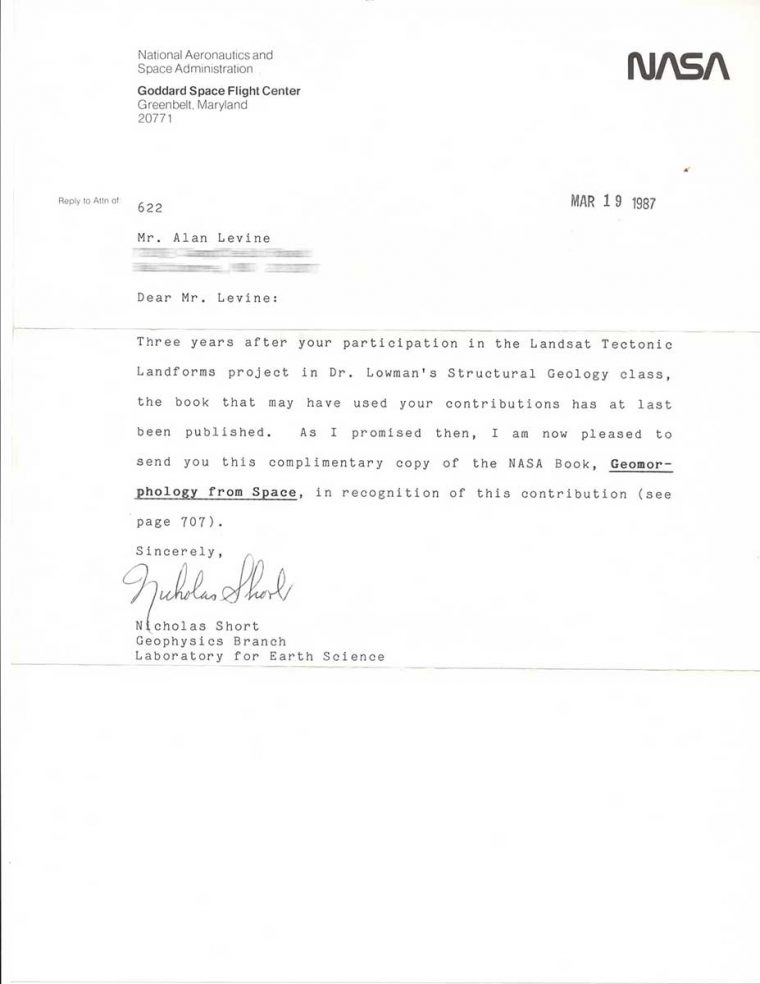A true story.
A NASA scientist who has a long career in using satellite imagery to study earth landforms is hired to teach a Structural Geology course at a university near where he works, Goddard Space Flight Center.
He is currently participating in the authoring/editing of a new textbook on Geomorphology. He creates an assignment where each student in the class is given one satellite image and it’s location. Their task is to write up the background research on the geology of the region in the image. Ultimately, their work is credited as part of a published book.
This is clearly an example of what David Wiley has championed as a “renewable assessment” as opposed to the more typical disposable assignment. George Veletsianos just published How do faculty benefit from renewable assignments? on the BC Campus news site.
I love this framing and use it often in talks; everyone knows the odor of disposable assignments.
That example above? I was a student in that Geology class at the University of Maryland.
It happened in 1984.
The NASA teacher was Paul D Lowman, who had quite a long “maverick” career at NASA. Lowman who passed away in 2001 after like 40+ years as a NASA scientist. I don’t remember him too well, he had a good sense of humor, but was also serious. And he definitely was cut from a different mold than other university professors.
I don’t have any memory of the exact assignment. I don’t have any artifacts from this long ago.
What I do remember is each students each got a photo print of a Landsat image, with likely a label with the location or the name of the Geological Feature (I was pretty sure I had the print, but alas it eludes me). I imagine I did all my research at the University Library, or maybe we got to go to a NASA one. Most likely I turned in a paper written on a typewriter. There likely were typos.
The book was published three years later as Geomorphology from Space: A Global Overview of Regional Landforms – as a NASA publication it’s in the public domain, and you can grab a 76 Mb version of it.
It’s an OER, right?
My project was the Pine Mountain Thrust located in the Kentucky/Tennessee region of the Appalachian Mountains. In the book it is featured on pages 58-59.

Description page for the Pine Mountain Thrust. As a student I did some of the background research that appears here.
As a contributor I have my own physical copy of the book and when I opened it I found the letter I got when it was mailed to me:

My personal letter from NASA that accompanied the book I received as part of my work in a renewable assessment.
And as promised, you can see me and my fellow students mentioned in the credits on page 707:
So the idea is really not new and I am sure it was done many times before Dr Lowman did it.
The thing is… most everything I see as an example of this idea is on the order of writing a piece of a textbook, be it an open one or something in Wikipedia. Those are the only kinds I see in George and David’s (and others) writing about the idea. The exception I see are some really great student produced videos David described that were done in 2007:
An early version of this assignment back in 2007 brought you Kennedy and Nixon debating the merits of blogs and wikis, Rick Noblenski: Blasting Caps Expert and Wiki Advocate, and a father and son confrontation over District Policies Regarding Blogs and Wikis
The Kennedy Nixon one is brilliant, with JFK arguing for wikis and Tricky Dick advocating blogs. Wait this is so good I am going to embed it.
But these seem almost the exception as everything is aimed at Stuff That’s Like A Textbook.
It’s not easy making assignments that are not responding to an essay question. I saw David struggle a bit with that first hand when I was part of the Creative Commons Certification project and we were trying to develop activities to show one’s application of CC in the world.

Working Hard at Making Renewable Assessments flickr photo by cogdogblog shared into the public domain using Creative Commons Public Domain Dedication (CC0)
I missed the photos where David was almost in anguish trying to come up with ideas. I wrote more on this as The Challenge of Non-Disposable Assignments.
I’m not claiming to have an superior expertise on this, but have had my hand in plenty of ones you will find in places like the DS106 Assignment Bank and the UDG Agora Challenge Bank where all activities had to produce something visible to the world at a URL.
Again it’s not easy to do something other than writing parts of textbooks and articles. Heck, I did that in 1984 😉
But I think there is a lot of room for a broader range of renewable assignments.
Featured Image: That’s my own copy of Geomorphology from Space: A Global Overview of Regional Landforms, as a NASA / US Government publication it is in the public domain with no copyright restrictions




love this Alan